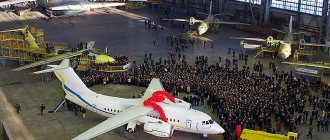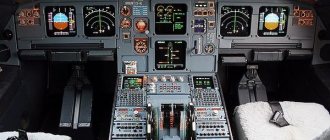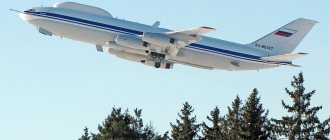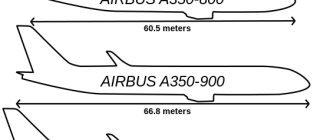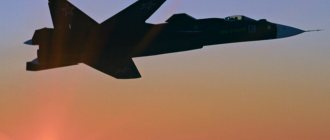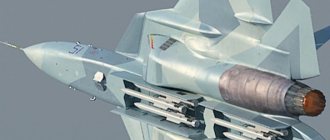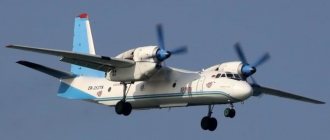The A380 is an aircraft created by specialists from the Airbus SAS concern. It is the world's largest passenger airliner. The vessel reaches 24.08 m in height and 72.75 m in length. The aircraft's wingspan is 79.75 m. In a single-class configuration, it can carry 853 passengers, in a three-class configuration - 525. The maximum non-stop flight distance is 15 thousand 400 km.
The work of the creators
As the developers note, the greatest difficulties were encountered in the process of searching for options for reducing the weight of the A380 aircraft. The aircraft was made lighter thanks to the widespread use of composite materials in the creation of not only power structural elements, but also auxiliary units, the interior and much more. In addition, the most advanced technological solutions and modified aluminum alloys were used for these purposes. Thus, 40% of the mass of the eleven-ton center section is carbon fiber. Glare hybrid material is used to produce the side and top panels of the fuselage. Laser welding of the skin and stringers of the lower fuselage panel made it possible to significantly reduce the number of fasteners.
The Airbus A380 is an aircraft that took about ten years to create. The cost of the grandiose project was twelve billion euros. According to Airbus representatives, for this amount to be recouped, it is necessary to sell four hundred and twenty copies of the aircraft. Based on this information, you can calculate how much the plane costs. The amount is impressive - 28 million 571 thousand 428 euros per copy.
Airbus A380-800 interior layout
Let us consider, as an example, the A380-800 cabin layout for three classes of Lufthansa airline for 526 passengers.
Economy class is located entirely on the lower deck, with a total of 420 passenger seats. The distance between the rows is 79 cm, and the width of the chair cushion is 43 cm.
50 row . There is a partition in front of him and legroom is limited. The tables are located in the armrests of the chairs, which is also not very convenient.
53 row . Comfortable seats with ample legroom.
Rows 58, 59, 73, 74 are located next to the toilets. The backs of the seats recline at a slight angle.
Rows 60, 61, 88 are quite comfortable seats. The space in front of them is quite large. But these places are not suitable for tall people; because of the partition, they will not be able to stretch their legs.
75 and 76 A, K – comfortable seats next to the emergency doors.
87 and 94 rows . Seats next to toilets. The backrests recline to a small angle.
Where it all began
The A380 is an aircraft that began to be developed with the following goals: to expand the range of Airbus SAS products and displace the Boeing-747 from its leading position. Debate about the final configuration of the aircraft ended in 2001. The first components of the A380 wing were produced in January 2002. Initial estimates put the cost of the program in the range of 8.7 - 8.8 billion euros. After the assembly of the first aircraft, this amount increased to 11 billion (later it was increased further).
It should be noted that employees of the Moscow engineering center Airbus ECAR made an invaluable contribution to the design of the A380F model. Thanks to the efforts of Russian designers, a large amount of work was completed on the design of individual parts of the fuselage, strength calculations were made, on-board equipment was installed and support was provided for serial production of the aircraft.
Where are components produced and how are they transported?
Specialists in France, Germany, Great Britain and Spain are working on building the main sections of the airliner. Due to their large size, these components were delivered to Toulouse via water and land transport. Some parts still fit into the An-24.
The tail and nose fuselage elements were loaded horizontally onto the Ville de Bordeaux (owned by Airbus) in Hamburg for shipment to the UK. The wing consoles produced at Broughton and Filton were delivered by barge to Mostyn. There these elements were loaded onto the aforementioned “Ville de Bordeaux” board. At Cadiz, the vessel received tail components and lower fuselage sections. Everything was unloaded in Bordeaux. From there the constituent elements were transported to Langon and then transported by land to Toulouse. Already assembled aircraft were sent to Hamburg for final equipment. The A380 is an aircraft that requires 3,600 liters of paint to cover (the total skin area is 3,100 square meters).
Tests
Modern aircraft undergo the most serious tests before being released into flights. The A380 model is no exception in this regard. Five aircraft were built specifically for comprehensive testing. The first aircraft was presented in Toulouse in January 2005. The first flight took place on April 27 of the same year. The flight team consisted of six people, led by Jacques Rossi, an experienced test pilot. The successful landing occurred after 3 hours 54 minutes. after takeoff.
A series of test flights started on December 1, 2005. It was then that the aircraft reached an impressive speed of 0.96 max during a shallow dive.
A380 is an aircraft (see photo above) that made its first transatlantic flight on January 10, 2006. The beginning of the same year was marked by the first unforeseen situation: during a static test at the Toulouse aircraft factory, the wing of one aircraft suddenly cracked, unable to withstand a load of 145% of the nominal load . As defined by aviation safety regulations, no change in integrity should occur at 150% of the specified load. As a result, the management of the Airbus consortium decided to make changes to the design of the aircraft's wings. Due to the addition of reinforcing elements, the total weight of the structure increased by thirty kilograms, fourteen of which were mounting bolts.
The first flight test of the A380 model with passengers on board was successfully carried out on September 4, 2006.
Business Class
The number of business class seats varies from 50 to 97 in different airlines. As a rule, business class seats are located on the upper deck separately from economy class passengers. There is even a separate telescopic ladder for them.
Some airlines provide passengers with a gift of transportation with a personal driver from the airport to their destination.
Also, business class passengers have access to the lounge on the upper deck, where drinks and snacks are served free of charge.
Business class seats fold out into a horizontal bed two meters long. For relaxation, each chair has pillows, blankets, and sleep masks. Each seat has a power outlet and a USB port. Wi-Fi is provided throughout the flight. There is also a screen with a large selection of films, games and entertainment programs. Some airlines offer a personal minibar with drinks and champagne.
The business class menu is served on china. Experienced sommeliers will advise you to choose suitable wines. The business class menu is updated every month.
Design Features
And 380 800 is a modification designed to carry 555 or 583 passengers (depending on configuration). In 2007, Airbus began offering customers a ship with a smaller capacity (525 seats) in exchange for an increased flight range (they managed to increase it by 370 kilometers). This transformation allowed us to achieve maximum compliance with premium transportation trends.
There is another modification of the airbus in question. This is a cargo version of the A380-800F. The aircraft is capable of transporting up to one hundred and fifty tons of cargo. The maximum flight range is 10,370 kilometers.
In the future, it is planned to produce jet passenger aircraft of the A380-900 modification. They will have a larger capacity (656/960 passengers) with a similar flight range.
Main characteristics
The model has two powertrain options. The first of these is the Rolls-Royce Trent-900 engine, and the second is the Engine Alliance GP7000 engine. In both cases, thrust reversers are installed on two of the four power units. The maximum flight range of the airliner is 15.4 thousand kilometers, while its cargo modification with 150 tons of cargo on board is capable of covering a distance of 10.3 thousand kilometers without refueling. The maximum take-off weight exceeds 650 tons. Moreover, experts claim that the wing parameters are sufficient for possible future, larger modifications of the Airbus A380. Its characteristics and configuration will be changed slightly.
Compared to its main competitors, the model is more economical. In particular, for every hundred kilometers of travel, one passenger requires an average of three liters of fuel. The weight of the aircraft itself is 280 tons. Reducing it, according to the developers, was one of the priority tasks even at the production stage. This was achieved through the use of composite materials, as well as improved aluminum alloys, to create most units and assemblies. As for the emission of harmful substances into the atmosphere, they (per passenger) amount to about 75 grams per kilometer of travel.
Pilots' workplace
To reduce the cost of additional crew training, all Airbuses are built with the same cockpit layout and flight characteristics. The A380 features an improved glass cabin. The steering wheels can be manipulated remotely using electric drives that are connected to the side control handle. The cockpit is equipped with the most modern information display devices. These are nine interchangeable LCD monitors measuring 20 by 15 centimeters. Two of them are indicators of navigation data, two display basic information about the flight, two more inform about the operation of the engines, one provides data on the current state of the entire system. The remaining two monitors are multifunctional.
To refuel the aircraft in question, you can use a mixture of natural gas and aviation kerosene with GTL.
Ensuring a comfortable flight
As experts have established, the noise level in the A380 cabin is half that of the Boeing 747. In addition, inside the aircraft in question, the air pressure is maintained at a higher level. Both of these factors are designed to ensure less fatigue for passengers during the flight.
Two staircases located at the tail and bow of the aircraft connect the upper and lower decks. The A380 offers impressive customization options. That is why, as noted by the Airbus concern, the growth in production rates is not as high as previously expected. The aircraft can be equipped with a shower cabin, a bar counter, a rest room, and a Duty Free store. Thanks to the presence of a satellite channel, passengers are provided with telephone communication or a wireless Internet connection (Wi-Fi).
Currently, air transportation within Russia using the A380 is not carried out. An order has been placed for four aircraft, but none of them have been built yet.
Spa showers on board the A380
Emirates and Singapore Airlines have installed showers for first class passengers. Each cabin has:
- shower, changing room and toilet;
- hairdryer, full-length wall mirror;
- heated floors, leather seats, exotic plants to maintain a relaxing atmosphere;
- cosmetic sets: shampoo, conditioner, moisturizer, liquid soap, scrub and eau de toilette.
Each shower has a 15.4" LCD monitor that shows images of air shows or an external television camera.
Unexpected situations
The first emergency occurred on November 4, 2010. On that day, the A380, owned by Qantas, was flying from Singapore to Sydney. One of the aircraft's engines failed just a few minutes after takeoff. The plane was forced to return to the airport in Singapore. None of the 433 passengers and 26 crew members were injured, Australian authorities said. In addition, the landing gear tires on the emergency side burst during landing. After this incident, the company's management decided to suspend the flights of all Airbus A380s it owned for two days until a detailed inspection was completed.
The second emergency occurred on April 12, 2011. Then the plane, belonging to Air France, caught the tail of the CRJ 700 aircraft with its wing. There were no injuries.
First class - private cabins
First class on board the A380 includes: Air France (9 seats), British Airways, Emirates and Qantas (14 seats), China Southern Airlines and Malaysia Airlines (8), Korean Air and Singapore Airlines (12).
Each first class seat is a small luxury cabin, which has everything you need for a comfortable flight: a wide, fully reclining seat, a pull-out table, a guest chair, a spacious luggage compartment, a mirror, and an entertainment screen. On the outside of the cabin there is a closet for personal belongings.
Some cabins are equipped with a double bed for two passengers.
The cabins are decorated with natural polished wood, leather, velor or high-quality plastic.
On night flights, passengers are provided with: pajamas, blankets and hygiene products. In addition, cosmetic sets are offered as gifts: several types of skin care products and eau de toilette from famous brands.
In first class, you can choose from several different gourmet menu options, from vibrant ethnic cuisines to healthy options. They can be ordered directly to your cabin or to the Lounge area. Cocktails, champagne and limited edition fine wines are offered throughout the flight.
On the A380, first class passengers have a Lounge seating area, where there is a bar, tables and sofas for a pleasant rest in company. The bar offers a large selection of drinks, desserts and snacks.


